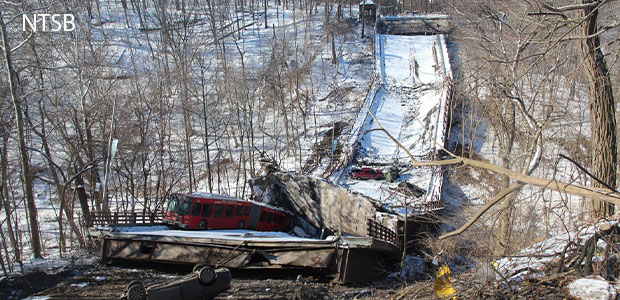
The National Transportation Safety Board Outlines Pittsburgh Bridge Collapse
PennDOT announces selection of the team to rebuild fallen Fern Hollow Bridge.
- By Shereen Hashem
- Feb 09, 2022
Officials in Pennsylvania are moving forward on building a replacement for the Fern Hollow Bridge in Pittsburgh, which collapsed on January 28, selecting a team of HDR Inc. and Swank Construction to design and construct the new structure and the approval of $25.3 million in federal funds for the project. The team "mobilized to the site an February 3 and began work," Pennsylvania Dept. of Transportation spokesperson Alexis Campbell said.
According to an article, the National Transportation Safety Board, which has launched an in-depth probe of the collapse, has released an interim report of the accident, which caused no fatalities but resulted in injuries to 10 people in vehicles that were on the bridge at the time of the collapse. As expected, the report, issued on February 7, includes factual details, but does not contain findings of the collapse's probable cause. That finding will be part of the NTSB’s final report, which will not be finished for perhaps 12 to 18 months, according to Chair Jennifer Homendy.
The interim report does, however, include some specific details. For example, it states, “Initial assessment of bridge components indicates that the collapse initiated at the west end of the structure.”
“Although certain areas of the welded steel girders were identified as being fracture critical, no primary fractures were found in these areas.” The report also states that “further examination will be performed as debris from the bridge is removed and unobstructed access becomes available.”
In addition, the NTSB report describes the 447-foot-long, four-lane bridge in detail, noting that it “was an uncoated weathering steel, three-span, continuous rigid 'K' frame structure with two welded steel girders, welded steel floor beams and rolled steel stringers.” The report continues. "The ends of the structure rested on reinforced concrete caps on stone masonry abutments. Each girder was additionally supported by two inclined, welded steel frame legs, also made of uncoated weathering steel, which rested atop concrete thrust blocks.”
NTSB also indicated that its investigation will cover the bridge’s design, condition, maintenance, rehabilitation, inspection and load-rating history. It added that it plans a forensic examination of several of the bridge's structural components, and said, “The recovery of evidence, including extraction and documentation, is expected to be a lengthy process.”
NTSB said, “All aspects of the collapse remain under investigation while the NTSB determines the probable cause, with the intent of issuing safety recommendations to prevent similar events.”
The report recounts details of the collapse, many reported earlier by media outlets. At about 6:40 a.m., when the bridge fell about 100 feet into Frick Park below, four passenger vehicles and an articulated Port Authority of Allegheny County bus were on the bridge. A fifth vehicle drove off the east abutment, according to NTSB. The bridge had a posted weight limit of 26 tons.
The Federal Highway Administration said that on February 1, it authorized PennDOT to use $25.3 million in federal formula funding for the project. Of that, $22.6 million will come from the Highway Infrastructure Program’s bridge replacement and rehabilitation funds. The other $2.7 million from the National Highway Performance Program.